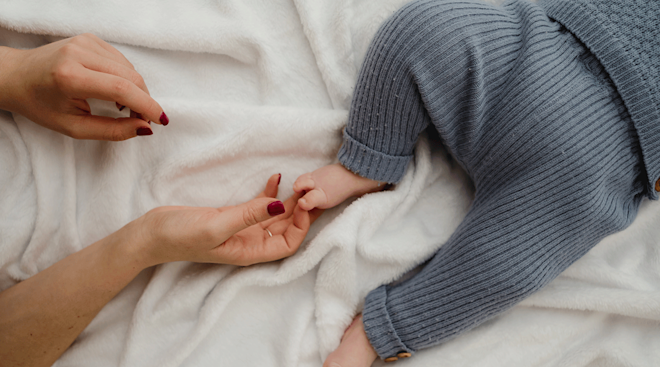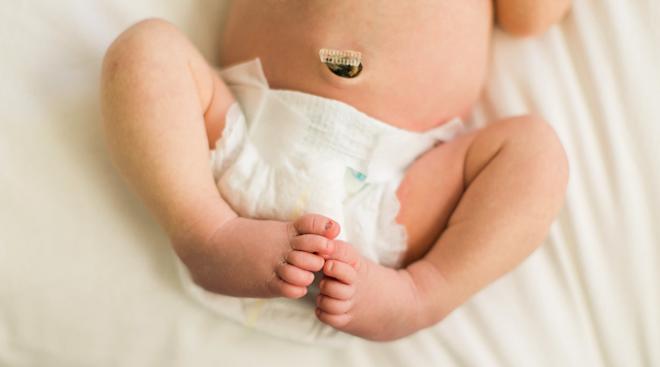How to Relieve Heat Rash on Baby
Babies are susceptible to tons of rashes, including diaper rashes, cradle cap and more. But one rash that can seem pretty alarming to parents is baby heat rash. These red bumps can show up fast—and even turn blistery. Read on for what causes heat rash on baby, how to relieve it and more.
Many babies experience heat rash, also known as prickly heat or miliaria. It’s most common in newborns between 1 and 3 weeks old, but can affect baby at any stage. Heat rash occurs when sweat gets trapped in the skin and can cause bumps, irritation and even blisters, says Mayo Clinic.
Baby heat rash is caused by blocked sweat ducts, explains Hannah Kopelman, MD, a dual-trained dermatologist at Kopelman Aesthetic Surgery in New York City. When these ducts become clogged, sweat traps under the skin and causes small red bumps and irritation. Heat rash on baby often happens in hot, humid conditions or when baby is overdressed.
“Babies are more susceptible to heat rash because their sweat ducts are not fully developed,” Kopelman adds. “This makes it easier for their sweat glands to become blocked.”
You can typically find baby heat rash in creases of the skin or parts of the body where clothes are tight, says Joel Warsh, MD, a board-certified pediatrician in Los Angeles specializing in parenting, wellness and integrative medicine. Symptoms can range from small bumps to large blisters. According to Seattle Children’s Hospital, symptoms in babies can include:
- Tiny pink or red bumps
- Rash on the neck, chest and upper back
- Itchiness
- Small fluid-filled blisters
- Rash can happen with no fever or sickness
Baby heat rash often looks like small red bumps, and is usually found on the neck, shoulders and chest, but it can also appear in skin folds like the armpits, elbows and groin, says Kopelman. “The rash can be itchy and uncomfortable, and the skin may feel prickly or irritated,” she says. Warsh adds that it can also look like blisters.
Baby acne vs. heat rash
Baby acne and heat rash can look similar, but there are key differences. “Infant acne is characterized by white or red bumps predominantly on the cheeks, nose and forehead, and is not exacerbated by heat,” says Warsh. Baby acne is also typically not irritated or itchy.
Even though baby heat rash usually goes away on its own, there are some things you can do to help alleviate it. “Keeping baby cool, dry and in loose clothing usually allows the rash to clear up without further intervention,” says Warsh.
Here are a few other home remedies Kopelman and Warsh recommend:
- Give baby a lukewarm bath
- Avoid lotions or ointments, since these may worsen pore blockage
- Use a cool, damp cloth to pat the rash
If the heat rash is more severe, Kopelman suggests contacting baby’s pediatrician, who can recommend applying a mild topical steroid to reduce inflammation.
How long does heat rash last on baby?
If you keep baby cool and dry, heat rash will typically clear up on its own within a few minutes or hours, says Warsh. However, every baby is different, and some cases of heat rash can last up to three days, says Seattle Children’s Hospital.
If baby’s heat rash doesn’t improve after three days, call the pediatrician, says Seattle Children’s. Other warning signs to watch out for are fever, infection, swelling or pus in the rash area, says Warsh. The bottom line? If baby seems to be in serious discomfort, reaching out to your doctor is always a great call.
Please note: The Bump and the materials and information it contains are not intended to, and do not constitute, medical or other health advice or diagnosis and should not be used as such. You should always consult with a qualified physician or health professional about your specific circumstances.
Plus, more from The Bump:
Hannah Kopelman, MD, is a dermatologist who is dual-trained in skin cancer and hair loss at Kopelman Aesthetic Surgery in New York City. She hosts the weekly Derm Club podcast, where she interviews other leading dermatologists and experts who share their perspectives and new advancements in their specialties. She earned her medical degree from Touro University.
Joel Warsh, MD, is a board-certified pediatrician in Los Angeles specializing in parenting, wellness and integrative medicine. Warsh earned his medical degree from Thomas Jefferson Medical College and has three additional degrees in kinesiology, psychology, and epidemiology and community health. He’s known for his popular Instagram account @DrJoelGator, where he offers weekly parenting and integrative pediatric support.
Mayo Clinic, Heat Rash, May 2022
StatPearls, Miliaria, August 2023
Seattle Children’s Hospital, Heat Rash, October 2023
Learn how we ensure the accuracy of our content through our editorial and medical review process.
Navigate forward to interact with the calendar and select a date. Press the question mark key to get the keyboard shortcuts for changing dates.





















































